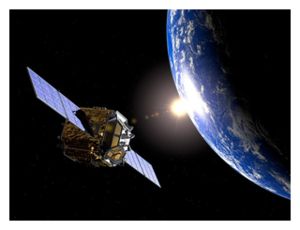This was originally published months ago. The asteroid is no longer mentioned in NASA official press releases.
Asteroid 2012 DA14, discovered early this year by the LaSagra Observatory in Spain, will pass inside the geosynchronous satellite ring about 35,800 km above the equator on Feb. 15, 2013. Astronomers say the asteroid may hit a communications satellite. National Geographic reports that Paul Chodas, a planetary astronomer at NASA's Jet Propulsion Laboratory (JPL) in Pasadena, California, said: "That's very unlikely, but we can't rule it out."
According to calculations, the asteroid will pass close enough to Earth to disrupt some orbiting satellites. Chodas, however, said that the orbiting International Space Station in low-Earth orbit is not at risk.
In spite of the fact that NASA astronomers assure that the asteroid will not hit the Earth, Steven Chesley, also of JPL, said: "We don't know exactly where it is, and that uncertainty maps through to an uncertainty in the orbit and predictions." The uncertainty, according to astronomers, means that they can't rule out that it will not hit Earth in subsequent close approaches to Earth after 2013.
NASA astronomers say there is an estimated cumulative 0.031% risk (1 in 3,230) of 2012 DA14 impacting Earth sometime between 2020 and 2082, a figure they hope to refine further as they collect more information during its close approach to Earth in February next year.
National Geographic reports that if the asteroid hits the the Earth, it will likely hit the Antarctica or the Southern Ocean because it approaches the Earth from the south. The impact of the 140,000 ton rock could release energy equivalent to a 2.4 megaton bomb, about the same as the 1908 Tunguska blast in which hundreds of square miles of forest in Siberia were leveled. According to Chodas, "If the asteroid were to strike the ocean, It could produce a tsunami," although "it probably wouldn't be big."
According to calculations, the asteroid will pass close enough to Earth to disrupt some orbiting satellites. Chodas, however, said that the orbiting International Space Station in low-Earth orbit is not at risk.
In spite of the fact that NASA astronomers assure that the asteroid will not hit the Earth, Steven Chesley, also of JPL, said: "We don't know exactly where it is, and that uncertainty maps through to an uncertainty in the orbit and predictions." The uncertainty, according to astronomers, means that they can't rule out that it will not hit Earth in subsequent close approaches to Earth after 2013.
NASA astronomers say there is an estimated cumulative 0.031% risk (1 in 3,230) of 2012 DA14 impacting Earth sometime between 2020 and 2082, a figure they hope to refine further as they collect more information during its close approach to Earth in February next year.
National Geographic reports that if the asteroid hits the the Earth, it will likely hit the Antarctica or the Southern Ocean because it approaches the Earth from the south. The impact of the 140,000 ton rock could release energy equivalent to a 2.4 megaton bomb, about the same as the 1908 Tunguska blast in which hundreds of square miles of forest in Siberia were leveled. According to Chodas, "If the asteroid were to strike the ocean, It could produce a tsunami," although "it probably wouldn't be big."
